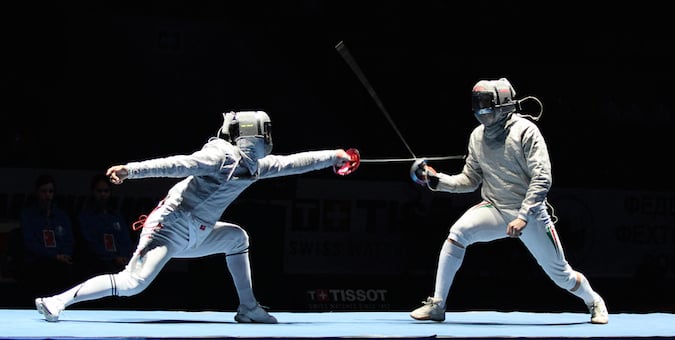Fencing movements: Stances

Image credit: Shutterstock.com
There are several stances and actions that every fencer needs to know in order to compete, be it in an assault or bout. Here are some of the most common.
First position
As its name suggests, this is the first position that fencers have to take in a competition. The fencer needs to have both feet together at the heel, so that a right angle is formed. In addition, the weapon, regardless of foil, epee or saber, is held in the dominant hand and pointed downwards, away from the opponent.
The salute
The salute precedes the beginning of every bout, and failure to salute both the opponent and the referee can result in a black card and elimination from the competition.
The fencer has to stand on the en-garde line with his dominant foot forward and pointing towards the opponent. Additionally, both feet should be in a ‘L’ position and shoulder-width apart, and the fencer should have his mask in one hand and his weapon in the dominant hand. Next, the fencer should point the weapon towards the opponent’s knees.
Once done, the weapon arm should be extended and raised until the hand is parallel to the ground, and the fencer should then bring in the elbow and pull the weapon backwards, so that it is upright and the hilt of the weapon is in front of his lips. To complete the salute, the fencer should then bring the arm and weapon down gradually.
En-garde
Another position that the fencer has to take before the match begins is the en-garde stance. This stance happens after the salute has been made.
With the feet still in the ‘L’ position – also known as the attention position – the fencer should then don the mask. However, in the en-garde position, the fencer’s knees should be bent significantly, and the weapon arm held out about one hand’s width apart from the body, with the elbow bent such that the blade is facing slightly upwards. The other hand should be positioned behind the body. The elbow of this rear arm should be bent and slightly below shoulder level.
To receive the latest updates on the happenings in the Singapore sports scene, or to find out more about some of the latest programmes on offer at ActiveSG, like our Facebook page here.





![ActiveSG Academies and Clubs Logo (Solid Colour)[8647]](https://www.activesgcircle.gov.sg/hs-fs/hubfs/ActiveSG%20Circle%202023Theme/images/ActiveSG%20Academies%20and%20Clubs%20Logo%20(Solid%20Colour)%5B8647%5D.png?width=150&height=65&name=ActiveSG%20Academies%20and%20Clubs%20Logo%20(Solid%20Colour)%5B8647%5D.png)




-01.png?width=200&height=141&name=Team%20Singapore%20Logo%20(Red)-01.png)



